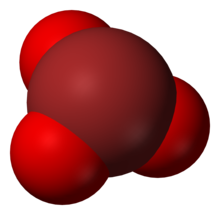Our website is made possible by displaying online advertisements to our visitors.
Please consider supporting us by disabling your ad blocker.
Bromate
 | |
 | |
| Identifiers | |
|---|---|
3D model (JSmol)
|
|
| ChEBI | |
| ChemSpider | |
| 1888 | |
PubChem CID
|
|
| UN number | 1450 |
CompTox Dashboard (EPA)
|
|
| |
| |
| Properties | |
| BrO− 3 | |
| Conjugate acid | Bromic acid |
Except where otherwise noted, data are given for materials in their standard state (at 25 °C [77 °F], 100 kPa).
| |
The bromate anion, BrO−
3, is a bromine-based oxoanion. A bromate is a chemical compound that contains this ion. Examples of bromates include sodium bromate (NaBrO
3) and potassium bromate (KBrO
3).
Bromates are formed many different ways in municipal drinking water. The most common is the reaction of ozone and bromide:
- Br−
+ O
3 → BrO−
3
Electrochemical processes, such as electrolysis of brine without a membrane operating to form hypochlorite, will also produce bromate when bromide ion is present in the brine solution.
Photoactivation (sunlight exposure) will encourage liquid or gaseous bromine to generate bromate in bromide-containing water.
In laboratories bromates can be synthesized by dissolving Br
2 in a concentrated solution of potassium hydroxide (KOH). The following reactions will take place (via the intermediate creation of hypobromite):
- Br
2 + 2 OH− → Br−
+ BrO−
+ H
2O
- 3 BrO−
→ BrO−
3 + 2 Br−
Previous Page Next Page


